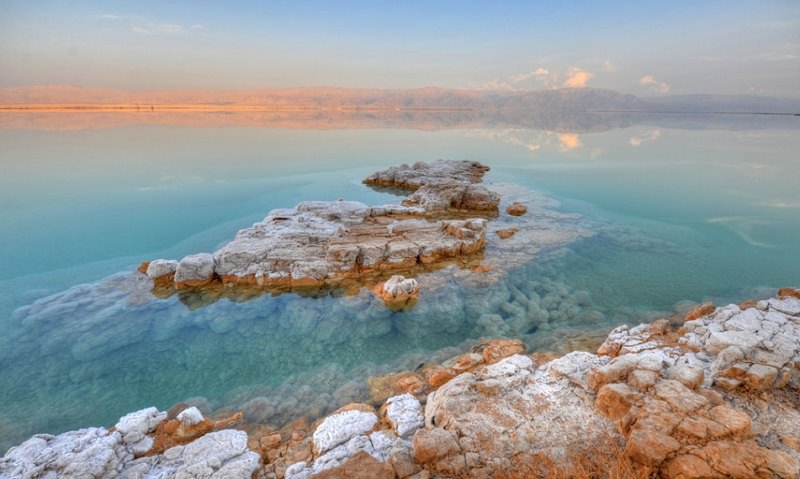The Dead Sea is one of the most unique bodies of water on Earth. Located between Jordan, Israel, and the West Bank, this salty lake earns its ominous name due to its high salinity that makes it difficult for most aquatic life to survive. While the extreme conditions may imply that nothing can live in the Dead Sea’s harsh environment, the reality is more complex. In this article, we will explore the fascinating microscopic ecosystems that manage to thrive in the hypersaline waters of the Dead Sea. Though it may seem devoid of life, this unusual lake still hosts resilient bacteria, archaea, algae and other microorganisms that have adapted to the challenging habitat. We will uncover the secret world of organisms that call the Dead Sea home.
Where is the Dead Sea?
The Dead Sea is a special lake located in Jordan, Israel, and the Israeli-occupied West Bank. It’s not like regular seas because it’s surrounded by land, making it a landlocked lake. The name “Dead Sea” comes from the fact that its water is super salty, making it difficult for aquatic life to survive. This lake has been getting smaller over the years, a process known as drying up. Even though it’s called a sea, it’s unique because it’s locked within the land and has this extremely salty water, creating a distinct environment that has fascinated people for a long time.
Microscopic Life in the Dead Sea
Beneath the surface of the Dead Sea, a hidden world of tiny life forms thrives, defying its extreme saltiness. Discovered by scientist Benjamin Elazari-Volcani in the 1930s, these minuscule creatures, including bacteria, archaea, algae, and protozoans, have adapted to the challenging conditions of the Dead Sea. The water here is so salty that regular marine life cannot survive.
This unseen microscopic community sheds light on nature’s incredible ability to endure tough environments, challenging our assumptions about where life can exist. Despite the inhospitable nature of the Dead Sea, these resilient microorganisms create a fascinating and unexpected tapestry of life in one of Earth’s most extreme places.
What Lives in the Dead Sea
In the Dead Sea, extreme saltiness keeps most life away, earning it names like the Sea of Death and the Sea of Salt. It’s not a typical sea where fish swim because the water is super salty. However, some tough beings manage to survive in this harsh environment. Bacteria and certain microorganisms and algae are the brave inhabitants of the Dead Sea. Despite its challenging conditions, these tiny life forms have found a way to live in this unique place. Imagine a sea so salty that it’s the lowest point on Earth, lying about 423 meters below sea level. It’s a special place where only the tiniest life forms dare to exist.
Why is it Difficult for Fish to Live in the Dead Sea?
Fish find it tough to live in the Dead Sea because it’s incredibly salty, earning it the name “dead.” The water here is much saltier than in the ocean, with a salinity of 33.7%. The Dead Sea doesn’t have an outlet, so water evaporates, leaving behind even more salt. Over time, this made the sea saltier. When floods carry fish into the Dead Sea from the Jordan River or smaller streams, they quickly perish. The extreme saltiness and lack of outlets make survival impossible for fish and other aquatic creatures, creating a challenging environment for marine life.
Freshwater Springs and Diverse Life

The Dead Sea, Earth’s deepest point, hides a surprising secret – freshwater springs! These springs are like hidden gems at the base of deep craters, some even 100 feet deep and 50 feet wide. Imagine long, deep springs, reaching up to 90 feet. A 2010 dive revealed these springs as bustling hubs of life. They host various microorganisms, forming biofilms on rocks and sediments. These springs are home to dense groups of cyanobacteria, especially in the hot springs like Zerka Ma’in and Zara. The Dead Sea’s mysterious freshwater springs create a thriving hotspot for diverse microbial life, adding a unique twist to this extraordinary environment.
Did the Dead Sea Turn Red During Floods?
In 1980, the Dead Sea transformed into a red wonder after a rainy winter. The reason behind this magical change was an alga named Dunaliella, which attracted red-pigmented halobacteria. These bacteria caused the water to turn red. During floods, the usually high salt level of the Dead Sea decreases from 35% to 30% or even lower. This drop in salt content creates a temporary burst of life, allowing the presence of Dunaliella and its interaction with halobacteria to color the Dead Sea in vibrant red hues, turning it into a visually stunning spectacle during unique and rare occurrences.
Final Words
The Dead Sea represents one of Earth’s most extreme environments, yet still manages to foster unique microscopic ecosystems. While the harsh conditions prevent most life from surviving, resilient bacteria, algae and archaea have adapted in remarkable ways. The rare freshwater springs act as oases, providing a sanctuary for diverse organisms. Even occasional floods bring an ephemeral explosion of red hues.
The Dead Sea teaches us that life finds a way even in the harshest habitats. This unusual lake offers more than its foreboding name implies and gives us a glimpse into nature’s incredible tenacity. As much as it seems devoid of life, it still harbors persistent organisms, revealing that complex microscopic worlds can thrive where we least expect them.

